#streltsy
Text
Don't mind me. I'm just posting some old WIPs that won't go beyond that... shame on me, yes.

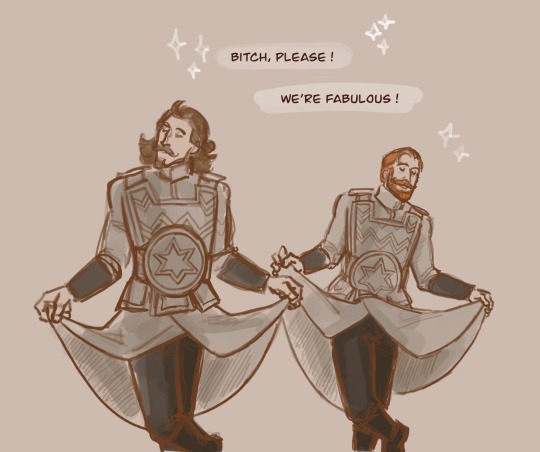

#Streltsy#Nikolai Pokrovsky (OC)#Dimitri Vavilov (OC)#Sergei Kovalevsky (OC)#Vasily Korsakoff (OC)#Pyotr Korsakoff (OC)#Kazimir Semenov (Allyn's OC)#Andrey Tcherenkov (OC)#Jean Lebol (OC)#WIP#dead WIPs#my drawings
16 notes
·
View notes
Text

Muscovite Streltsy (16th-18th centuries) as illustrated for Mount & Blade: With Fire and Sword. Cozy kaftan style overcoats. I like the red ones, but other colors like blue, green, and yellow were also used. In Siberia they used black, grey, or brown as the material was cheaper.
10 notes
·
View notes
Photo

Watslawa surrounded webtoon panels 5-6 wip Panels 5-6 done. I'm using modern Russian and Russian Cyrillic as this man's native tongue. I'm not too familiar with the older versions or Old Church Slavonic, otherwise I would have used that instead. But the speech is written with DeepL assistance so I might ask my Russian friend to correct what he's saying if it's not correct. #digital #wip #digitalsketch #digitalart #clipstudiopaint #panel #webtoons #webcomic #lineart #inking #surrounded #landsknecht #sword #standing #streltsy #bardiche #arquebus #16thcenturyfashion #historicalfantasy #outdoors #plain #hill #monotone https://www.instagram.com/p/ChpRVfKLitq/?igshid=NGJjMDIxMWI=
#digital#wip#digitalsketch#digitalart#clipstudiopaint#panel#webtoons#webcomic#lineart#inking#surrounded#landsknecht#sword#standing#streltsy#bardiche#arquebus#16thcenturyfashion#historicalfantasy#outdoors#plain#hill#monotone
1 note
·
View note
Text
As Russia Celebrates Veteran's Day, Here's How the Country Fought in Different Periods of Its Thousand Year History
How Military Service in the World's Largest Country has evolved, from Tsars to Bolsheviks to the Modern State

Servicemen take part in a dress rehearsal of a military parade marking the 77th anniversary of the victory over Nazi Germany in World War II, in Moscow, Russia. © Sputnik/Evgeny Biyatov
For over 100 years, Russia has celebrated Defender of the Fatherland Day on February 23. The holiday, which originally glorified the Red Army, took on wider meaning after the fall of the USSR. Presently, the holiday sees Russians celebrating all those who served in the military in defense of their country.
It is roughly equivalent to the American Veteran's Day or the British Armed Forces Day.
The military has always been respected in Russia. But over the country’s thousand-year history, the system has undergone major changes.
Varangians: Strangers From The North
At the dawn of the existence of Rus, the Slavic tribes that populated the land that would become Russia had no army of their own. Whenever conflicts became violent, they resembled 'wall on wall' fist fights. These confrontations continued in this manner until the Slavs learned the art of war from their northern neighbors and colonizers – the Varangians.
The Varangian guard, which took control of the trade route that passed through central Rus to the Greek civilizations, called themselves 'rowers', since they used row boats in their military campaigns. It is thought that the ancient Scandinavian word “rōþr” at some point evolved into the similar sounding 'rus'. It’s highly likely that the future name of Russia thus sprang from the self-designated name of the Varangian warriors.
The people of Rus wore simple shirts and helmets. They were mainly armed with spears and axes, while a sword marked a warrior’s superior status. They fought on foot, moving along rivers on boats called drakkars, which were rolled over rapids. The Varangians engaged in the great Viking tradition of trade and raids – pretty much the same as in Western Europe at the time.
One of the most famous Varangians and first rulers of Rus was Grand Prince Svyatoslav, who fought Bulgaria, the Byzantine Empire, and the Khazar khaganate. Some sources mention large raids as far away from the center of Rus as the southern Caspian lands.
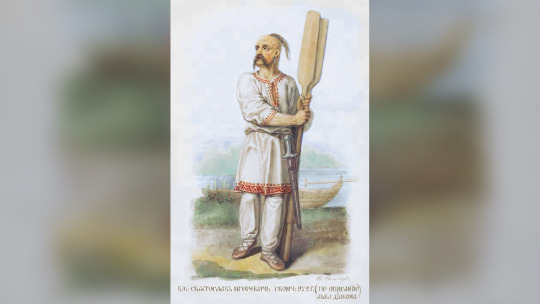
Svyatoslav Igorevich (according to the description of Leo the Deacon). © Wikipedia
Boyars-Vigilantes: The First Warriors in Rus
As the ancient Russian principalities were established, grew more powerful, and formed a settled economy, the Varangian-Rus people increasingly assimilated. In their turn, the Slavs adopted Varangian methods of warfare. This process, along with the need to protect the territories under their control, resulted in the formation of a new kind of military organization – the princely vigilante squad.
These were boyar warriors from among the prince’s loyal inner circle. They equipped themselves with war horses, armor, pikes, and swords at their own expense. In military campaigns, the unit was accompanied by a foot detachment of 200-300 spearmen. These combat groups were quite mobile and were able to quickly respond to the raids of the Polovtsians and Pechenegs. Unfortunately, by the time of the Mongol invasion, these detachments had not sufficiently evolved – still small in number and dispersed, they could not effectively fight the horde from the East.
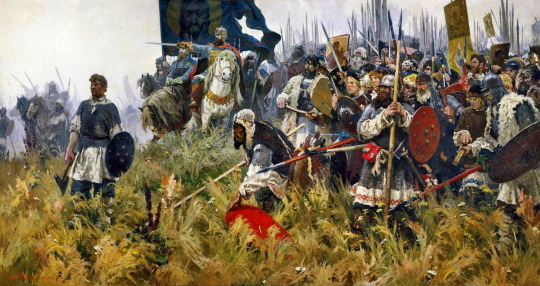
'Morning on Kulikovo field' by Alexander Bubnov
Streltsy: The First Permanent Army
Despite the defeat by the Mongols, the vigilantes and local militias continued fighting during the internecine wars of the 14th and 15th centuries, until a single state was formed under Ivan the Terrible.
It was then that the first unified regular army appeared in Russia, called the Streltsy. This reform occurred in 1550 and a special order (ministry) was created. This first army wasn’t large – it consisted of no more than 3,000 soldiers. However, the Streltsy were paid and were not obliged to work the land, which greatly facilitated social mobility in those days. The privileges, allowance, and a rather free lifestyle made the new profession extremely popular, and within 50 years, there were over 20,000 Streltsy in Moscow and the regions.
The Streltsy wore a kaftan and gloves and had uniform weapons. They were armed with a “bardishe” (poleaxe with a long shaft), a “pischal” (the Russian equivalent of an arquebus or long gun), and a saber. To achieve greater firing accuracy during important battles, the shaft of a bardishe was used to support the pischal. The Streltsy also often carried low-power powder grenades.
In addition to military duties, the Streltsy had civic duties, acting as policemen and firemen, They also often interacted with the local cavalry. In battle the Streltsy were directly responsible for the capture of Kazan (1552) and Astrakhan (1556), and most importantly, the retention of these territories.
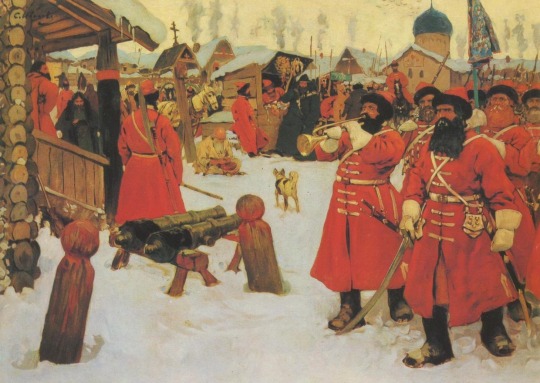
Sagittarians. Fragment of the painting by Sergei Ivanov 'Tsar. XVI century.'
Russia Learns From The West
After the fall of the Rurik dynasty and the onset of the Smuta (The Time of Troubles), Russia was forced to adapt and change its military system because of the prolonged war with Poland and the occupation of Russia’s northern territories by Sweden. To fight the occupation, “foreign formation regiments” were organized. These military units were made up of servicemen, “willing” free people, foreigners, Cossacks, and other mercenaries.
The new regiments did not replace the Streltsy but used more modern tactics to fight. This included the placement of pikemen in front of the musketeers, which increased the tactical manoeuvrability of combat detachments.
By the 1630s, the foreign formation regiments had evolved into the first Hussar and Reiter companies. These were in fact knights with long pistols. They wore cuirasses and helmets, but when attacking, they fired dozens of heavy bullets at the enemy and then either retreated to reload or finished the enemy off with daggers and these meter-long pistols.

Uniforms II. Russian troops. 1. A soldier of a foreign regiment before Alexei Mikhailovich. 2. The era of Peter the Great. The bombardier. 3. The era of Peter the Great. An officer of the Grenadier regiment. © Wikipedia
Peter The Great’s Reforms – The First Conscription Army in Russia
Although the Hussar and Reiter regiments were quite effective, they still weren’t large enough. The Streltsy, who took on the role of a mass army, unfortunately engaged in a dispute with the young Tsar Peter I. The conflict prefaced large-scale military reform. In 1705, the future emperor and founder of the Russian Empire issued a decree “On the recruitment of soldiers from free people”. It was then that the term “recruit” was legally endorsed. Peter I “copied” this innovation from Sweden, which had a strong regular army.
The decree stated that from each village, town, community, and household, one person (except for the head of the family and the breadwinner) must be sent to the army for a lifetime of service and must become a soldier. This person was to be chosen by lot. In the early years of the law, all classes were subject to conscription. All nobles were obliged to serve in the army, and communities were required to regularly provide a certain number of recruits between the ages of 20-35.
In addition to the professional army, Peter I also established the Russian navy, military industry, and military academies.
By the end of Peter the Great’s reign, the regular army numbered 200,000 to 300,000 in all military service branches. This was an impressive number for a country with a population of 13 million. The duration of military service also became shorter over time. Lifetime military service was dispensed with, and soldiers went into “reserve”, being called to the army only in case of war. However, for many decades the duration of military service didn’t drop below 20 years.

'Battle of Poltava' by Pierre-Denis Martin
The Army of The Empire
The next major reform of the Russian army took place in the 19th century. Any defeat brings with it necessary lessons, and such was the case with the Crimean War, which resulted in Milyutin's sweeping reforms. The main innovation was the transition from Peter the Great’s recruitment system to universal military service – a standard practice in European armies. From that time on, all men between the ages of 21 and 40 were required to be on active military duty. In the ground forces, the duration of service was 15 years: six years of active service and nine years in reserve. After that, men were enlisted in the State Militia (the reserve of the armed forces, convened only in case of war) until they turned 40.
Additionally, instead of permanent armies and corps, Milyutin formed military districts with stationed units. This meant that soldiers and officers no longer had to permanently live in tents.
The second half of the 19th century was also marked by qualitative changes. Particular attention was paid to the army’s technical equipment. The end of the century saw the development of aeronautical and railway units. In 1885, a team of military aeronauts was formed (using hot air balloons or airships), with the East Siberian Field Aeronautical Battalion taking part in the Russo-Japanese War of 1904-1905. In 1911, the first aviation detachment appeared in Russia, and by the beginning of the First World War, there were 39 such groups. The famous “Ilya Muromets” heavy bombers also appeared at that time.
In those years, state-owned factories and logistics expanded, all combat units were equipped with machine guns, and telephone lines were installed between the various units.
Fundamental changes also concerned military service admission. The term of active service in the infantry and foot artillery was three years, in other branches of the ground forces it was four years, and in the Navy, it was five. Some categories of citizens were given privileges. Men who were unable to carry weapons for health reasons and some clergy were exempt from military service.

Russian Infantry © Wikipedia
The Soviet Army
In the first months after the October Revolution of 1917, the Soviet government sought to create an army based on the militia system. This supposed that during peacetime, military units would consist only of the accounting apparatus and limited command staff, drawing upon locally registered fighters in times of need.
In the first months following the revolution, the army was composed of volunteers with the number of troops reaching just below 200 thousand. In order to create a regular army, the resolution "On the organization of the Red Army" was adopted on July 10, 1918. Men from 18 to 40 years old were subject to conscription and by November 1921, the Red Army numbered 5.5 million.
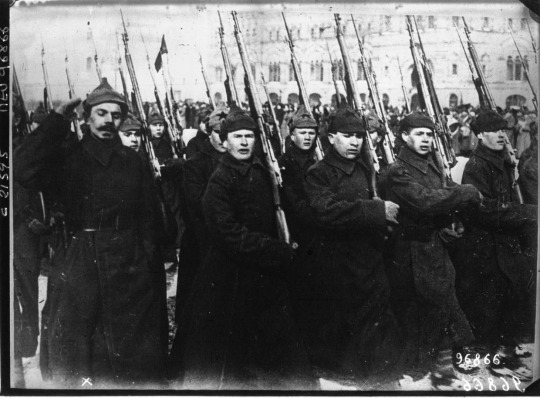
Parade on Red Square, Moscow, 1922. © Wikipedia
Nazi Germany’s invasion of the Soviet Union became a real test for the army, and the Soviet military system was not ready for it. Victory in the war cost the USSR the lives of tens of millions of people.
The conflict completely transformed Russia’s military system. In 1946, the Workers' and Peasants' Red Army was replaced by the Soviet Army. In the 1950s, the Armed Forces of the USSR were equipped with nuclear missiles and other advanced military equipment. The Soviet Armed Forces consisted of Ground Forces, Strategic Missile Forces, Air Defense Forces, the Navy, and the Air Force. This has all been inherited by the Russian Federation.

Solemn march of Soviet Army tanks at the parade in honor of the anniversary of the October Revolution, November 7, 1983. © Wikipedia
Present Times
In Russia’s recent history, the army was at its largest in December 1991, when it numbered about 3.8 million servicemen. In 1992, Boris Yeltsin reduced the number of servicemen to 2.1 million in 1994 and by 1996, to 1.7 million.
At the end of August 2022, Vladimir Putin signed a decree increasing the personnel of the Armed Forces of the Russian Federation from 1.9 million to 2.04 million. This came into effect on January 1, 2023.
The Ukraine conflict has impacted Russian military service. Partial mobilization was announced for the first time in the history of the Russian Federation, and 300,000 people who had previously served in the army were called up. Moreover, private military companies became more prominent in light of the conflict.
Among these, the most widely known organization is PMC Wagner Group – currently one of the most effective units of the Russian military.
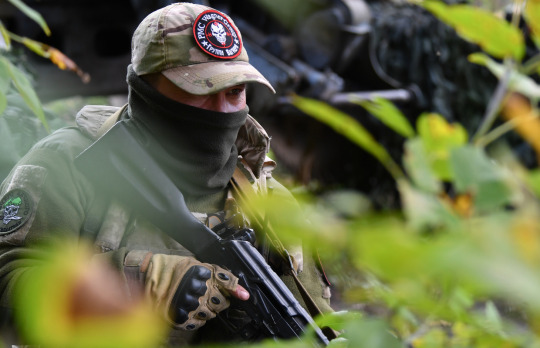
A serviceman of Russian private military company Wagner Group is seen during the execution of a combat mission in the course of Russia's military operation in Ukraine, in the Lugansk People's Republic, Russia. © Sputnik/Viktor Antonyuk
— By Anatoliy Brusnikin, Russian Historian and Journalist | February 23rd, 2023
#Russia 🇷🇺#Veteran’s Day#Military Service#World’s Largest Country#Bolsheviks#Modern State#Varangians#Boyars-Vigilantes#Streltsy#Conscription Army#The Soviet Army
1 note
·
View note
Text
Watslawa surrounded webtoon panels 7 wip 2
Just added a few more details to the same panel. Might edit it though before I move onto the next ones.

#digital drawing#wip#digital sketch#digital art#clip studio paint#panel#webtoons#webcomic#lineart#inking#surrounded#landsknecht#sword#standing#streltsy#bardiche#arquebus#16th century fashion#historical fantasy#outdoors#plains#monotone#hill#trees
0 notes
Photo

Prettied up doodle of a kislevite Streltsi. Coolest unit in Warhammer 3.
348 notes
·
View notes
Text
99 tabs on wikipedia and it's all filled with shit like info about specific streltsy regiments
17 notes
·
View notes
Note
Recently saw a post about streltsy. Was wondering on the upsides and downsides of using long guns and what is essentially a two handed axe at once.
Would you toss the gun to the side when the enemy got to close Or just hold it in one hand and use the axe one handed?
I can’t imagine it was terribly effective since we didn’t see copycat designs and formations all over the place…
So, an important piece of context, I'm not exceptionally familiar with the streltsy in particular. The streltsy were an early Russian gunpowder unit from around the 1550s until the 1700s. The name itself translates (basically) to “rifleman.” These were soldiers armed with arquebuses. Technically, the organization itself had both infantry and mounted units.
An important detail, that's not a two-handed axe, it's a bardache. These were a shorter polearm designed to function as a stabilizer for a handgun or arquebus. (Keep in mind, in this case, the “handgun,” refers to a longarm.) I'm not sure how many nations used this specific combination, but Russian and Polish forces both fielded units armed with arquebuses and bardaches. (I think the Austrians did as well, but I'm not certain of that.)
The general combination of melee and gunpowder was very prominent at this point in history, so in the contemporary context, the streltsy weren't that unusual.
Starting in the mid-fifteenth century, European militaries fielded “pike and shot” units and formations. The firearms of the time were single shot and required considerable time to reload. The were also not particularly accurate (by modern standards), and not particularly powerful. This created a situation where handgunners would be vulnerable while reloading. A number of units (including the streltsy) practiced various forms of volley fire, where one group of gunners would fire, and then fall back and reload while another line would step forward, and fire, before repeating the processes. However, even under the best circumstances, units of handgunners were vulnerable to melee infantry, and didn't have the firepower necessary to keep enemy soldiers from wandering over and poking them full of holes. The implementation of pike and shot was specifically intended to provide a counter to this. Instead of a unit of handgunners (or arquebusiers), pike and shot formations would include a mix of handgunners and pike infantry. If the enemy attempted to engaged the handgunners in melee, the pike infantry would move in and intercept those attackers. (Specifically, pike and shot units were often arranged with the pike wielders in the center of the column, flanked by wings of handgunners. Alternately, the pike infantry may be located directly behind the firing line, and able to move forward to counter any advancing infantry who reached the handgunners.) The exact mix of pike and gunpowder varied wildly over the centuries. But, the basic concept of a mixed melee and gunpowder unit wasn't that strange historically. As firearms became more powerful, and with the development of the bayonet, pike and shot units became historical footnotes.
The most unusual element with the streltsy was simply that they had both a melee weapon and firearm. Normally in a pike and shot formation, a soldier would be equipped with one or the other.
If attacked in melee, I suspect the proper response would have been to sling or stow the arquebus and then fight using the bardache. Though, some streltsy carried sabres, which would have been another defensive option. Also (somewhat unsurprisingly) some streltsy units included actual pike infantry. So, there were conventional pike and shot streltsy units.
Ultimately, for the time, the combination of a melee weapon and firearm was not particularly strange, and the specific combination of an arquebus and bardache wasn't random. Those were weapons that worked well together.
-Starke
This blog is supported through Patreon. Patrons get access to new posts three days early, and direct access to us through Discord. If you’re already a Patron, thank you. If you’d like to support us, please consider becoming a Patron.
66 notes
·
View notes
Text
The sword of the day is the bardiche.
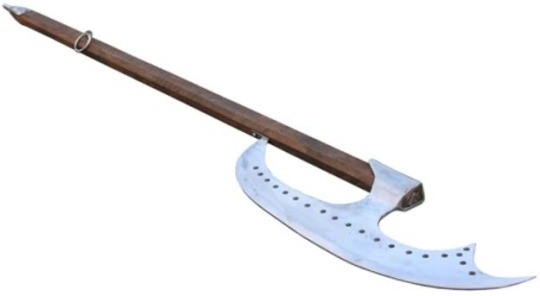
The Bardiche is a polearm, and a development of the Dane axe. Its head features an extraordinarily large cutting surface for an axe, sometimes exceeding two feet in length. Conversely, its haft was relatively short for a polearm, under 5 feet. The blade had a crescent shape, often connecting to the haft at the bottom, and the top came to a point that could have been used for thrusting. The streltsy, 17th century Russian riflemen, used this weapon for another purpose too; while it was brutally effective in melee combat, they used the top of the weapon as a support for their rifles.
26 notes
·
View notes
Text

Peter has a Russian spirit. This spirit outweighs all his other roots: Icelandic, Irish, Scottish. This spirit is very old, but at the same time infinitely mundane and free.
And no matter how hard Peter tries to divert attention from himself with a series of jokes and self-irony: I know that his head is always occupied with a deep and complex search for a path and eternal rest.
Peter can be represented in any era and images. But this work of the spirit most fully coexisted in the body of the archer whose hands were hardened from the scythe and battles, and yet remained just as sensitive to carving toys from soft wood or touching thin strings.
And so Petr Rataj appeared.
Petr is calm, powerful and taller than anyone else in the Streltsy regiment. And if he wants to rest he goes to the field to take care of the ground.
***
Works on the field Petr,
Waving a maple scythe
And Rataj has black hair swaying
What does crumble with black silk
Rataj has the clear eyes of a falcon
And his eyebrows are black sable.
And boots green morocco
The caftan is green velvet.
Silent and thoughtful bogatyr
It's not fun for him to revel and walk around the world,
He wants to return to his family
And weave a green ribbon into the white-apple tree where his house once stood.
***
#type o negative#ton#peter steele#peter ratajczyk#metal#doom metal#gothic metal#art#fanart#Ton Fanart#type o negative fanart#digital art#goth
27 notes
·
View notes
Text
But like Czar Peter content to toil in the shipyards of foreign cities
I did not expect to meet Peter the Great in Moby Dick, and even less with this reference, but of course, of the many things to note about the Tsar, this is undoubtedly the most characteristic. But not the only one. And since Melville has given me the opportunity to share one of my obsessions, namely the crazy biography of the greatest (literally and figuratively) Tsar of all the Russias, here is a very long post about the figure, work, life and death of a man with only one dream: Ships.
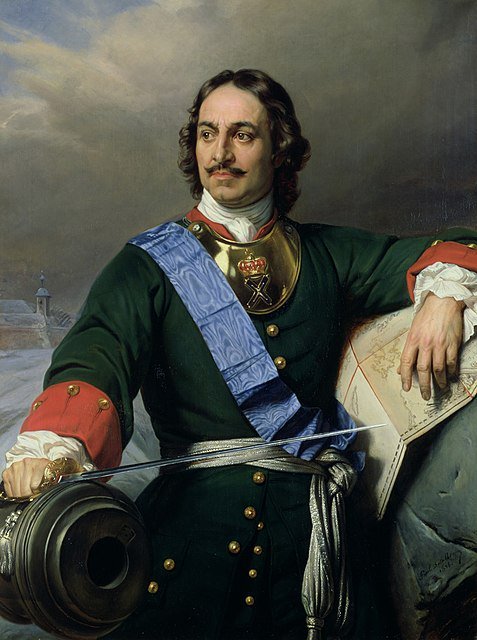
Prince Pyotr Alekseevich was Tsar of Russia, prince of Moscow, Kiev, Vladimir and Novgorod. Tzar of Kazan, Astrakhan and Siberia. Sovereign of Pskov. Grand Prince of Smolensk, Tversk, Yugorsk, Permsky, Vyatsky, Bulgarsky and others. Sovereign and Grand Prince of the lands of Novgorod Nizovsky, Chernigovsky, Ryazan, Rostov, Yaroslavl, Belozersky, Udorsky, Kondiisky and and Sovereign of all northern lands. Of the lands of Iberia (not that one, the other one), of the Kings of Kartlia and Georgia, of the lands of Kabardin, of the Princedoms of Circassia and the mountains and many other states and lands east and west, here and there, and successor and sovereign and ruler.
All this piece of land:
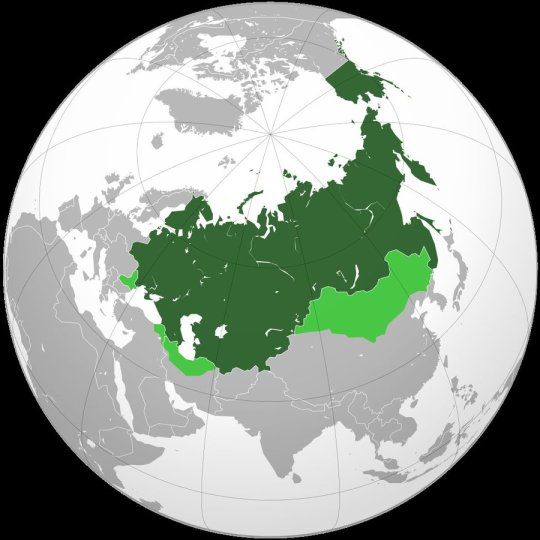
Half of those places have Dragonlance Kingdom names, let's face it.
And it's not easy to govern: seven time zones, fourteen thousand languages, tongues and dialects, myriad cultures, religions and traditions, and the outlet to the sea where God lost his cap. In this beautiful Frankenstein country, Peter was born, the son of Natalia Naryshkina and Alexei I, Tzares of Russia. One of their 13 children, I mean.
The Tzar will be survived by five of his Tzarevichs and at his death he will be succeeded by his son Fyodor III, Peter's elder brother:

Fyodor was 15 years old when he was crowned Tzar of it all.
Educated by the most renowned monk of the time, he spoke Polish and Latin. He was in poor health, half-paralysed and disfigured, but he was a reformer, and began to ventilate the country, which smelled like a bear.
He founded the Academy of Sciences and reformed the law to ease punishments. And he eliminated the "pedigree" system by which public offices were elected in Moscow, the mestnichestvo, unblocking decades of administrative paralysis.
And here is a necessary aside:
The mestnichestvo consisted of civilian and military positions being determined by seniority and family. And that's it. In other words, if you were the fifth son of the Whateverovich family, you could be a third corporal of the Fifth regiment of Irkusk sappers. That's all you need to do, just ask for it and you get it.
Now imagine the entire administration and army of the Duchy of Moscow organised like this. There was a register of all the families and positions so that everything was clear and concise. If anyone dared to sit in your place at the Tzar's table, it came to blows.
The whole administration was full of useless people in high positions because they won the genetic lottery, and capable people eating a turd because they were born in the wrong family, or two months late. It was a real mess.
So Fyodor said enough is enough and ordered the books to be burned. The boyars were not amused by this.
Anyway, good old Fyodor dies and THE PIPHOSTION ensues.
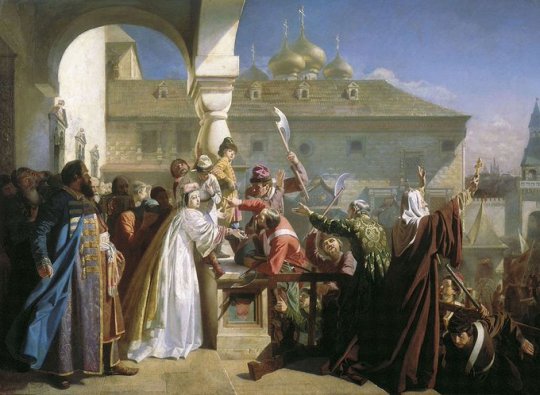
Welcome to the Moscow Uprising of 1682*.
Two sides are fighting for the succession, the Miloslavsky and the Naryshkin. The latter want to appoint Peter Tzar. The former accuse the latter of having murdered Ivan, Peter's half-brother.
Then the Streltsy's arrived.
The Streltsy were a military unit of musketeers with bardiches, who double as police and fire brigade. It's a virtually hereditary post (to no one's surprise) and they lived in their own neighbourhoods in Moscow.
And they were pissed off.
*They order them by date because, as you can imagine, this had more sequels than TRANSFORMERS.

The truth is that the Streltsy are chronically underpaid by the state, which forces them into trade or agriculture. They are also used as border guards in the provinces and as siege troops, which takes them away from their business.
The Moscow Streltsy allies with Ivan's supporters. On 11 May, amid general unrest, they storm the Kremlin and lynch their own officers and several boyars. A few days later they storm the palace and kill several nobles in front of the ten-year-old Peter. It ends with Ivan V as Tzar, Peter as heir and his sister Sophia as regent of all the Russias.
Sophia is, of course, behind the riots.

The infant Tzars "rule" from a double throne. The Tzarevna Sophia sits behind the throne and whispers answers to Peter.
Literally.
She orders to make a little window in the back of the throne.
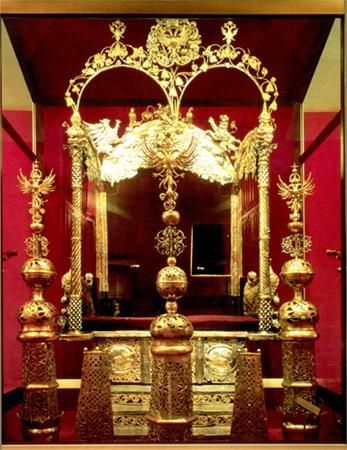
This matters little to Peter: he is the "second" Tzar, he is not going to inherit a shit, and he has an education to take care of, at a time when education was not very interesting.
Except for him.
Peter began his studies with a church accountant named Nikita Zotov. Tzar Fyodor III had already taught the boy his first letters, and recommended his mother to continue with it. Zotov came out of nowhere, was given a flat in Moscow and began to educate.

Zotov freaks out a bit, but he gets on with it. Peter is not a genius, but he is very curious, and when something interests him, it interests him. A lot. They hit it off, the Tsar and the accountant, and Zotov and Peter will be friends for the rest of their lives.
Another of Peter's tutors is Patrick Gordon, a Scottish soldier of fortune who ends up in Russia on the run from the Calvinists. Our wandering Scotsman (and other wandering Scottish chums) go off to the Swedish-Polish war and fight for five years.
On both sides. Several times.
Between him and Paul Menesius, another Scottish soldier of fortune, they educated young Peter in the ways of war. You can see that Russia and Scotland were strangely linked in those years. It is not clear who came up with the idea, but the way to teach young Peter about the things of war was with The Toy Army.
Not "a": THE.
Peter's Toy Army (Poteshnye voiska in Russian) was a unit of 100 sons of the court nobles and diplomats, friends of Peter, along with servants and enlisted personnel more or less by force.
Trained with live ammunition by the Scots.
To learn the art of war, Peter created his war in the Palace courtyard, with artillery, muskets and all the trappings.
The Toy Army was expanded and trained to become the Preobrazhensky and Semenovsky Regiments of the Imperial Guard.
You know that Sci Fi/Fantasy cliché, that breed of invincible warriors raised for WAR from childhood and so on and so forth?
WELL, THAT'S WHAT PETER THE GREAT SET UP: HIS OWN ELITE UNIT OF RUSSIAN SUPER-SOLDIERS.

Peter the Great was the greatest. Of Russia. And of Europe.
No, really.
The Tsar of the Russian Empire was two meters and three centimeters tall, in a century when the average height was around one meter sixty-five.
Summer 1689. Peter is 17 years old, has two regiments of super-soldiers and a mission: to turn Russia into a maritime power. Because someone, we don't know who, has taught young Peter to sail, and he has got the idea into his head.
Peter plans to wrest power from his half-sister Sophia, after she led two disastrous military campaigns in Crimea. Sofia discovers the coup attempt and recruits her Streltsy to stop it. But Peter's loyalists tell him and he flees to the Troitse-Sergiyeva monastery.

Peter entrenches himself in the convent, and his friends come to help him. The boyars also take his side, as do some of the Streltsy. Sophia eventually loses her grip on power, and Peter I takes control of all the Russias.
Because Ivan V is ill.
Since his birth, Ivan V has always been sickly and weak, both in body and mind. He has no interest in government and spends his days in prayer and fasting. He will not be drawn into the coups and counter-coups between his sister and his half-brother.

After his marriage, Ivan gradually disappeared from court life. At the age of 27 he was senile, paralysed and half blind. His death will be the end of the period of the Two Tsars and the beginning of the single rule of Peter I, although since he takes Sophia out of the way Peter is already the Tsar.
Back to Peter.
The first thing he does is to modernise Russia. All of it. The whole thing. From the wardrobe to the army, Peter wants his empire to be a modern nation, like Prussia, England or France, so he reoganises the whole medieval mess he has at home.
With the help of the Scots he overhauls the army and puts it to work as his Imperial Guard. The church is being carved up, he sets up the bishops himself and controls it from the synod. Although he knows the Bible well, it is clear that Peter is not a communicant.
Another thing is the way people dress, which is something he can't cope with.
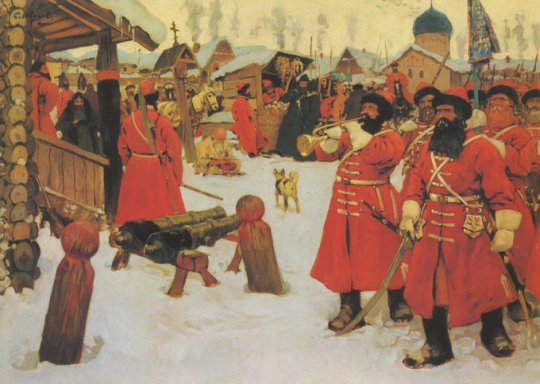
So as a measure to implement the fashion, create a tax on long tunics and beards. Yes, a tax on beards. Every hipster neighbourhood would be up in arms today.
He also set his second great goal: to be a maritime power, because he really liked ships.
At the time, Russia had only two sea outlets: the Pacific, which was a fucking huge distance away from Moscow, and the White Sea, which is only really liquid for like a couple of months of the year.
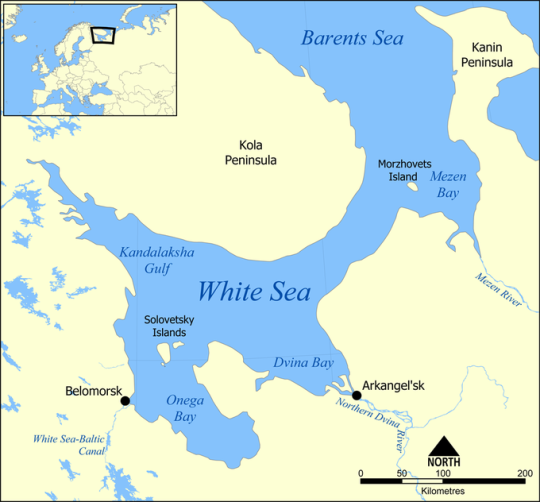
Indeed, Russia is cut off from the North Sea and the Mediterranean. From the former by the Swedes, who are quarrelling with everyone at the time, and from the latter by the Ottomans, who control access to the Black Sea, where Sofia's campaigns to take Crimea have been unsuccessful.
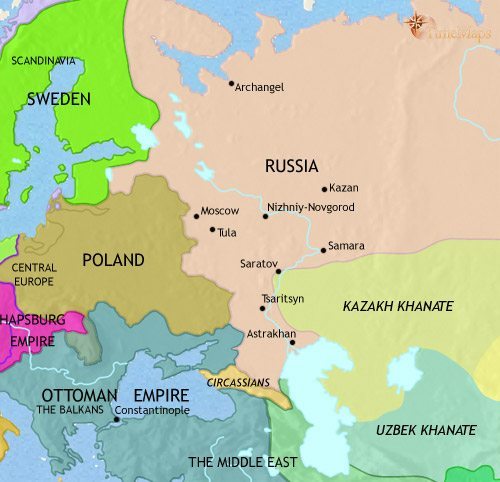
Peter goes FULL WARHAMMER and starts the Azov Campaigns.
Seriously, THE AZOV CAMPAIGNS.
Azov is an Ottoman fortress that stands between Peter and the Black Sea. After making a few arrangements with Poland to pass through, Peter goes overland with two armies for his well-deserved passage to the sea, along with his loyal Scots.
They fail to take Azov.
Although there have been victories, they fail to hold the ground they have gained and must retreat, leaving the fortress back to the Ottomans. But Peter has a plan, and a fixed idea. So he get back to Moscow and builds a fucking fleet and sets off down the river with his new toys: the first Russian Navy Fleet.
And this time Azov falls.
In less than a year, the Russians build and arm a fleet and defeat the Ottomans, taking the fortress than have resisted all previous attempts to be taken.

Bombarded and besieged by sea and land, unable to receive reinforcements and supplies, with the Ottoman fleet on the run, Peter I the Great achieves his first victory and proof that the Russian fleet is more than a passing fancy. Two years after his victory at Azov, the Russian Navy and its first port are created. Although the Ottomans still control Crimea and the Black Sea, the Russian fleet begins to become a reality.
Faced with the Ottoman threat and the need to bring closer ties with the Europeans he so admires, Peter I organises The Grand Embassy, a group of some 300 nobles and diplomats that he sends to Europe to make friends for the Russian Empire. All as part of his master plan…
… to learn how to build more, better ships!
This is where I tell you that the socio-economic conditions in Europe created the need for Peter I's new Russia to open up to the sea, the relations between England and the Danes, etc., but what am I going to fool you?
Peter I wanted ships. Full stop.
So he sends the Grand Embassy to travel around Europe and look for allies against the Ottomans… And to learning about ships.
1697. The 17th century comes to an end. The Grand Embassy travels through Poland and the Germanic principalities, seeking further support for their war against the Ottomans. Their efforts are unsuccessful, but contact will soon bring other unexpected fruits.
The journey west continues.
In late summer the Grand Embassy arrives in Holland. For four months the diplomats meet with other diplomats and nobles. The Ottomans mattered to no one so far from their borders, and in Spain there were more worrying matters: the succession of Charles II.

Heading the embassy is Franz Lefort, a former Swiss soldier of fortune in the service of Tsar Peter I, and one of his closest friends.
Lefort has served with Patrick Gordon in Kiev, and participated in the firsts disastrous Crimean campaigns. Lefort has also done diplomatic work for the Tsars, and during the capture of Azov, he served as admiral of the Russian fleet. The Tsar is a common guest in his household and the social life of the court gravitates around him.

Along with Lefort, Count Fyodor Golovin, another of Tsar Peter's close associates, has been appointed as Count Fyodor Golovin, a boyar with a military career and a world. A lot of world.
During Sophia's regency, Golovin was sent to defend Albazin, by the Amur River:

Defend it from whom?
Well, this man:

This man is the Kangxi Emperor, the fourth of the Quing Dynasty, and one of the most famous and prosperous emperors of the dynasty.
Precisely because he did not allow himself to be pushed around by the Russians, among others.

(Albazin was about where Jixi is now).
Did I forget to mention that this is THE BORDER WITH CHINA?
Yes, where DIO lost his sandal. That's where Golovin was sent with nearly 700 men.
Anyway, not much of a joke: when Golovin arrives in Albazin, the Chinese have destroyed the fort. He rebuilds it, improving the defences, and rallies his men. And the Chinese troops begin a gruelling siege that lasts more than half a year. Of the more than 800 Russians, 66 survive.
The situation was resolved diplomatically, and the Russians leave the banks of the Amur River, the Black Dragon.
Golovin returns to Russia. The real one. At that time, such a journey was the stuff of science fiction, mind you.
This is Golovin, a veteran and friend of the Tsar, who is commissioned by Peter I to hire naval experts and buy modern weapons while he travels around Europe with the Grand Embassy.

Golovin was not only in charge of scouting naval talent: He also brought with him a group of naval engineers, master shipwrights and workers whose mission was to learn the cutting-edge techniques of the shipyards of Europe. One of them was Pyotr Michalov.
Pyotr was apprenticed in the shipyards of the largest fleet of the time, the Dutch East India Company, for four months and five days, and his master certified that he learned all branches of the trade and behaved properly. We know because the documents that certified such learning has been recorded and stored.

But Pyotr Michalov kept a secret… Badly.
He was actually Tsar Peter I!
Peter I. Peter I The Great. THE GREAT.
The two-metre tall Russian, one of the tallest men in Europe, regent of the continent's largest nation, has been working "incognito" in the shipyards for months.
Officially, he is not present at the Grand Embassy. He is still in Russia.

And, officially, the rest of Europe's nobles pretend they know nothing about the two-metre Russian who wants a job in the shipyards and asks a lot of questions and is then accompanied by the authorities to see the new ships.
Nothing at all. No. Niet.
Because Peter likes ships. He LOVES to work the timber and to create the hull and to literally build them. He didn't like to be treated like a nobleman and to be seen like a boss: He want to work with his own hands and to learn the tricks and secrets of the artisans and workers. That's whats Melville talking about when he wrote:
But like Czar Peter content to toil in the shipyards of foreign cities, Queequeg disdained no seeming ignominy, if thereby he might happily gain the power of enlightening his untutored countrymen.
After the Netherlands, the Grand Embassy visited England, where it was clear that all the great powers of the time were more concerned about Spain than Russia. Pedro looks for a comfortable place to spend the winter, but above all close to the Deptford shipyard, where he will once again work "incognito" as a simple worker.
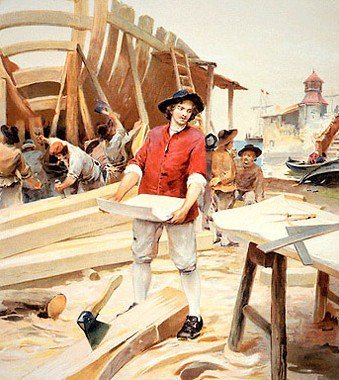
The Grand Embassy is housed at Sayes Court, working in the dockyards and on diplomatic missions, and generally doing Russian: using portraits as shooting targets, destroying gardens with wheelbarrow races, sealing doors and windows with mud…
One of the house servants wrote to his master, John Evelyn (yes, that John Evelyn):
"There is a house full of people and right nasty."
Evelyn claimed damages from the Crown, and had to be compensated almost €40000 in today's currency. It seems he didn't like his guests' habit of using the furniture as firewood.
After the British winter, which is Russian for "pretty nice weather", the Grand Embassy continued on its course through Europe. Since it was clear that the Ottomans were of no importance to anyone, the Russians concentrated on the Swedes, who blocked their access to the Baltic. And here history takes away a unique opportunity. One of those things that make you dream of a uchronia where the world could have been different. Where possibilities are multiplied and juxtaposed in an unrepeatable fractal. One of those almost perfect moments.
Peter & The Embassy are in Poland when the Streltsy Uprising of 1698 breaks out, putting an end to the Grand Embassy and forcing the Tsar to rush back to Russia...
JUST AS THEY WERE ABOUT TO VISIT VENICE!!!!
The Streltsy are fed up. They get paid too little, too late and too badly, and on top of that the Moscow ones have been in Azov for two years. When they are sent to a new posting instead of back to Moscow, they get angry.
A group returns to Moscow to complain, and ask Sophia Alekseyevna, THAT Sophia, for her intercession. 2300 Streltsy head to Moscow with the intention of reinstalling Sofia on the throne. Peter sends 4000 loyal soldiers under Patrick Gordon.
The Streltsy are defeated, captured and cruelly tortured to death, whipped or exiled.

The Streltsy were disbanded in the following years, and Peter I never again toured European countries. The Grand Embassy had taught Peter many things, and it was on his return that the modernisation of Russia began.
With the beard tax.
He also changed the calendar, moving the beginning of the year from September to January, from 7207 to 1700.
After reforming the army by sending home 70% of the officers, and ensuring with treaties that Azov would remain in his power, he turned to Sweden. Peter the Great wasted no time during the Great Embassy. Between building ships and destroying other people's property he still had time for diplomacy. With Poland and Denmark he declared war on Sweden.
The Swedes are doing very well in Europe. The Baltic is theirs, and they have a modern, professional army that allows them to stand up to others who are numerically superior, as Peter is about to find out.
Their king, Charles XII, this steampunk-looking gentleman, will have to deal with Russians and Poles, and although he wins early victories, he will make THE MISTAKE.

The Russians are being cocky at the beginning of the war, conquering to the north-west. The plan is to get an outlet to the Baltic because ships, you know. So they take what will be Estonia, Latvia and Lithuania and keep it. They lay siege to Narva.
Pyotr, who has the attention span of an amphetamine-blind gerbil, leaves a foreign general, De Croÿ, in command of the siege to go somewhere else.
It ends as expected. The Russians are wiped out. The Swedes' tactics disrupt the Tsar's formations and although they outnumber the Swedes 4 to 1, the Russians have neither training, discipline nor morale. The Russian army is slaughtered and surrenders within hours.
But not all.
The Preobrazhensky and Semyonosky Regiments hold their positions and fortify themselves, fighting back while the rest of the Russian troops flee, kill their own foreign officers and surrender to the Swedes.
They are the Toy Army Regiments, and they will not surrender until they are completely surrounded and decimated.

And what is Pyotr doing meanwhile? Founding St. Petersburg, his outlet to the sea and future Imperial Capital:

While Charles XII continues his moves against his other enemies, Russia offers him peace: he now has two seaports, St. Petersburg and Kronstand. Pyotr can now build his fleet and play with his little boats, so he is not interested in war.
But Charles XII will make THE MISTAKE. Rejecting the peace offerings, the Swedes will invade Poland and continue with Ukraine. Their goal: Moscow.
And what always happens when someone tries to invade Russia will happen.
The Russians do not put up a fight, they retreat and burn everything behind them. They wait for winter to catch up with the enemy. At the Battle of Poltava, the Swedes, exhausted and starving, are crushed. Charles XII has to flee south, where he is taken in by the Ottoman Empire during his exile. Russia will win the war and become the modern maritime power that Pyotr always wanted. Charles XII will never forgive himself, and it is not until his death in battle a decade later that peace is signed between Russia and Sweden.
By then, the Swedes had had enough of the Russian navy, which bombarded and attacked the coast year after year, often directly under Peter I's command.
A fleet built from scratch, based in St. Petersburg and Kronstand, in less than five years. Pyotr will continue to reign as Tsar of all the Russias, facing revolts, plots and various wars.
And partying. A lot of partying.
Peter had another passion besides ships. With his friends from the Toy Army, Zotov, Golovin, Lefort, Gordon and others, he would meet at Lefort's house, until the house became too small for him. So much so that Pyotr paid for a palace for 1500 people. Pyotr awarded titles to his buddies, organised sledge races, drinking ceremonies and more parties.
200 colleagues.
Partying.
With the Tsar.
The Grand Embassy was clearly a Russian-style Erasmus.
And finally, the death of our great Pyotr.
Legend has it that Peter was in St Petersburg visiting a shipyard, of course, because Peter the Great was not going to visit a bakery, as we all know… During the visit, Baltic November, Peter saw that some soldiers had fallen into the water and were in danger. Being a naturally courageous person, Peter jumped into the Baltic and there he went, to save his fellow citizens. In November.
And so it was that Peter I the Great, Tsar of All the Russias, etc, etc, died of pneumonia, doing heroic things because he was like that, a very tall man, a very Tsar, who propelled his country 300 years into history, while he lived 600 years ahead of the rest.

I wish Pyotr had discovered zeppelins.
And to bid farewell to this great man, the statue I like the most, without epicness or grandiloquence. The image of a man and his passion:

"Alas! I have civilized my own subjects; I have conquered other nations; yet I have not been able to civilize or to conquer myself."
#Whale Weekly#Moby Dick#Herman Melville#Peter I The Great#European History#Russia#17th Century#18th Century#I don't like the Great Men's History but... He was a GREAT MAN#Also an absolutist monarch#But for the Tsars that come before and after him... Not that bad
49 notes
·
View notes
Text

Decided to post the whole drawing on Tumblr
5 notes
·
View notes
Text
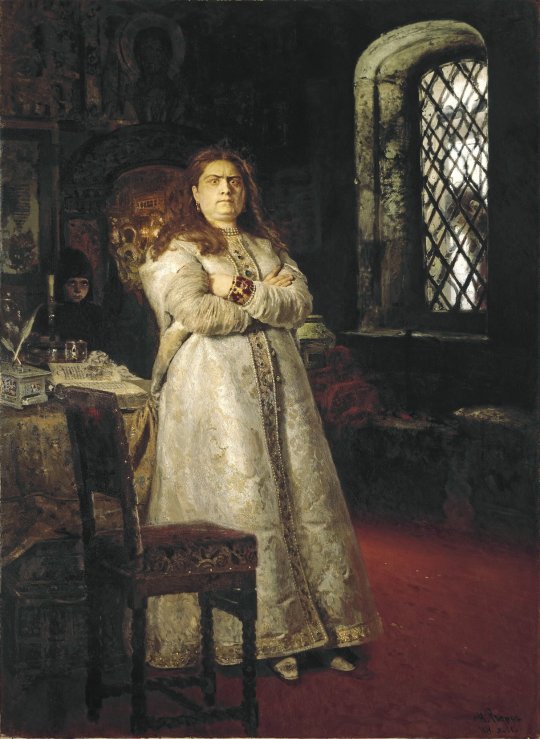

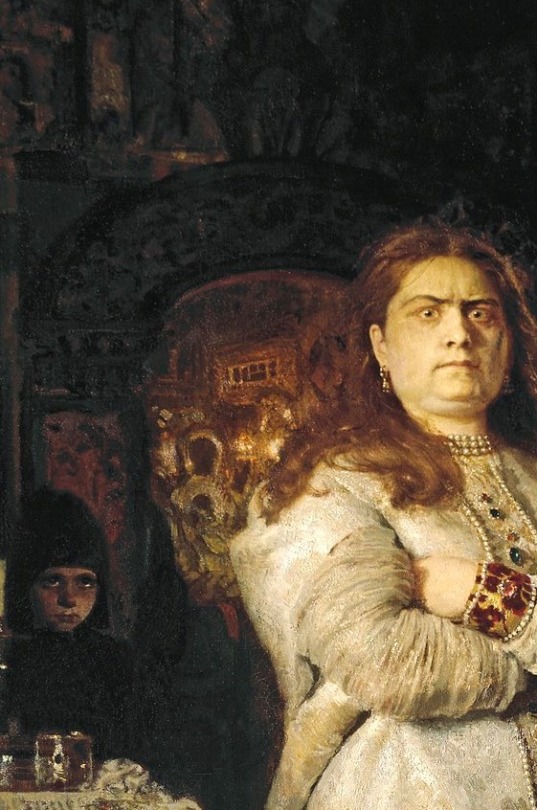
Princess Sofia Alexeyevna a Year after her Incarceration in the Novodevichy Convent during the Execution of the Streltsys and the Torturing of All Her Servants in 1698 (1879) by Ilya Repin
4 notes
·
View notes
Photo

Watslawa surrounded webtoon panels 7 wip 2 Just added a few more details to the same panel. Might edit it though before I move onto the next ones. #digital #wip #digitalsketch #digitalart #clipstudiopaint #panel #webtoons #webcomic #lineart #inking #surrounded #landsknecht #sword #standing #streltsy #bardiche #arquebus #16thcenturyfashion #historicalfantasy #outdoors #plains #monotone #hill #trees https://www.instagram.com/p/CiNUUpDr2JK/?igshid=NGJjMDIxMWI=
#digital#wip#digitalsketch#digitalart#clipstudiopaint#panel#webtoons#webcomic#lineart#inking#surrounded#landsknecht#sword#standing#streltsy#bardiche#arquebus#16thcenturyfashion#historicalfantasy#outdoors#plains#monotone#hill#trees
0 notes
Photo

Starting off this blog with a ref-sheet of my OC, Igor Snegov! He’s the main antagonist of sorts of my Grand Hunt story that I’ll primarily be posting about here.
Some more info about him under the cut as not to dump it all out here!
Before The Pelt
Once upon a time Igor was a fur trader and artisan before being recruited among the first unit of Streltsy, he primarily worked in military operations but would also work along border patrol when not at war.
Turning
Igor was known for his ruthlessness in battle and apparent blood lust the longer he'd be in service. His proficency and effectiveness nearly earned him a title of Warlord but he humbly refused as he wanted to stay a foot soldier and battle head on still. As he got older his body started to take its toll and he began to grow desperate to continue fighting. This eventually lead to engaging the superstitious and rituals of witches.
One such ritual worked, and he became as much a wolf as he was a man, melding with the pelt he'd shorn from a great wolf and ravaging a nearby settlement. When he was found he was nearly executed quietly but soon was pardoned as his new nature was discovered and he became a tool of war much to his own delight. He'd continue on like this until the death of the Romanovs, when he'd realized a swath of the revolutionaries knew what he was and had prepared the necessary steps to hunt him down through weaknesses inherent in Lycans.
Now
Igor traveled across Europe, leaving a bloody pack in his wake as he was chased out of town after town. He finally traveled to America shortly after world war 2 and started to lay low through the cold war. Recently he's started to come out of the woodworks again with more ruthless and reckless abandon, taking to hunting down Monster Hunters and dispatching them brutally.
Personality
Igor is loud and headstrong. He’s very set in his ways and spends most of his time these days in underground fighting rings, be they mortal or supernatural in nature, pubs or bars, or going out to valleys and wooded areas to run free for some time. He is brutish and values strength both of body and of spirit vastly. He does have quiet moments where he weaves blankets or works on his tailoring but it’s overshadowed by his tendency to cause trouble and reap havoc.
#Igor Snegov#Wurdulac#the grand hunt#oc#original character#russian#slavic#lore#reference sheet#illustration#character design#werewolf#Gus Draws
6 notes
·
View notes
Text
Watslawa surrounded webtoon panels 7 wip
I haven't posted for a week. Sorry about that. Was demotivated and didn't feel like drawing (along with some other factors). Anyways, getting back into it slowly again.
For now, I drew Watslawa standing there, staring at the noble. For some context on why she's there, in my head it's that she's wanted in the place (the poster she had said 'Wanted' along with the price on her head and her portrait) for reasons that involve breaking the law of that land of the local lord. She 'wandered' into the place, with intention of being a nuisance once more, for good reasons.
It's a proto comic of Watslawa. It's something I'm just using to practice and probably won't keep this idea.

#digital drawing#wip#digital sketch#digital art#clip studio paint#panel#webtoons#webcomic#lineart#inking#surrounded#landsknecht#sword#standing#streltsy#bardiche#arquebus#16th century fashion#historical fantasy#outdoors#plain#monotone
0 notes